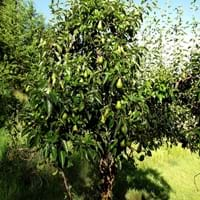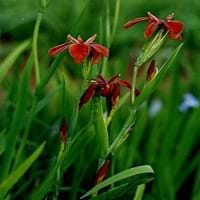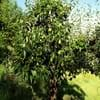Life Span
Perennial
Perennial
Origin
Europe, Western Asia
Southeastern United States, South-Central United States
Types
Green Anjou, Red Anjou, Bartlett
Apricot Queen, August Flame, Autumn Fire
Number of Varieties
Not Available
Habitat
Humid climates, moist forests
Fields, marshes, Swamps
USDA Hardiness Zone
3-8
6-11
AHS Heat Zone
9-5
Not Available
Sunset Zone
2a, 2b, 3a, 3b, 4, 5, 6, 7, 8, 9, 14, 15, 16, 17, 18
H1, H2, 3a, 3b, 4, 5, 6, 7, 8, 9, 10, 11, 12, 13, 14, 15, 16, 17, 18, 19, 20, 21, 22, 23, 24
Habit
Oval or Rounded
Clump-Forming
Flower Color
White
Orange, Dark Red, Orange Red, Copper, Chocolate, Black
Flower Color Modifier
Not Available
Bicolor
Fruit Color
White, Yellow, Red, Green, Yellow green
Brown
Leaf Color in Spring
Light Pink, Red, Green, Light Green
Green
Leaf Color in Summer
Dark Green
Green
Leaf Color in Fall
Purple, Dark Green, Burgundy
Green
Leaf Color in Winter
Light Green
Light Green
Leaf Shape
Oval with a pointed tip and fine teeth along their edges
Long Linear
Plant Season
Early Spring, Winter
Spring
Sunlight
Full Sun
Full Sun, Partial Sun
Growth Rate
Medium
Medium
Type of Soil
Loamy, Sandy
Clay, Loam, Sand
The pH of Soil
Acidic
Acidic, Neutral, Alkaline
Soil Drainage
Well drained
Poorly Drained
Bloom Time
Fall, Summer
Spring, Late Spring
Tolerances
Drought
Drought
Where to Plant?
Ground
Container, Ground, Pot
How to Plant?
Grafting, Seedlings
From Rhizomes, Seedlings
Plant Maintenance
Low
Medium
Watering Requirements
Medium, Water less during winter, Water more in summer, when new, water every week
Do not let dry out between waterings, Needs Very high moisture
In Summer
Lots of watering
Lots of watering
In Spring
Moderate
Moderate
In Winter
Average Water
Average Water
Soil pH
Not Available
Acidic, Neutral, Alkaline
Soil Type
Not Available
Clay, Loam, Sand
Soil Drainage Capacity
Not Available
Poorly Drained
Sun Exposure
Full Sun, Partial Sun
Full Sun, Partial Sun
Pruning
Remove damaged leaves, Remove dead branches, Remove dead leaves
Remove damaged leaves, Remove dead branches, Remove dead leaves
Fertilizers
Ammonium Nitrate, Fertilize the soil before planting
organic fertlizers
Pests and Diseases
Red blotch
Mosaic potyvirus
Plant Tolerance
Drought
Drought
Flower Petal Number
Single
Single
Foliage Texture
Medium
Medium
Foliage Sheen
Glossy
Matte
Attracts
Aphids, Birds, Butterflies, Pear psylla
Butterflies, Hummingbirds
Allergy
Anaphylaxis, Digestive Problems, Itchiness, Swelling
Poisonous to grazing animals
Aesthetic Uses
Cottage Garden
Bog Garden, Water gardening
Beauty Benefits
Good for skin, Improve skin tone, Making cosmetics, Moisturizing, Skin Problems
Not Available
Environmental Uses
Air purification, Shadow Tree
Air purification
Medicinal Uses
Cancer, Cardiovascular problems, cholesterol-lowering, Detox, Diabetes, Energy, Fiber, Heart problems, High blood pressure, Obesity, Treating diverticulosis, Weight loss
Sedative
Part of Plant Used
Bark, Fruits, Leaves
Flowers
Other Uses
Used As Food
Oil is used for aromatherapy
Used As Indoor Plant
No
No
Used As Outdoor Plant
Yes
Yes
Garden Design
Not Available
Bog Garden, Water Gardens, Wildflower
Botanical Name
PYRUS communis
IRIS fulva
Common Name
Pear
Copper iris
In Hindi
नाशपाती
Copper Iris
In German
Birne
Copper Iris
In French
Poire
Copper Iris
In Spanish
Pera
Cobre Iris
In Greek
Αχλάδι
χαλκός Iris
In Portuguese
Pera
Copper Iris
In Polish
Gruszka
Miedź Iris
In Latin
Orbis
Iris Copper
Phylum
Vascular plant
Magnoliophyta
Class
Magnoliopsida
Liliopsida
Family
Rosaceae
Iridaceae
Clade
Angiosperms, Eudicots, Rosids
Angiosperms, Monocots
Subfamily
Amygdaloideae
Iridoideae
Number of Species
Not Available
Importance of Pear and Copper Iris
Want to have the most appropriate plant for your garden? You might want to know the importance of Pear and Copper Iris. Basically, these two plants vary in many aspects. Compare Pear and Copper Iris as they differ in many characteristics such as their life, care, benefits, facts, etc. Every gardener must at least have the slightest clue about the plants he wants to plant in his garden. Compare their benefits, which differ in many ways like facts and uses. The medicinal use of Pear is Cancer, Cardiovascular problems, cholesterol-lowering, Detox, Diabetes, Energy, Fiber, Heart problems, High blood pressure, Obesity, Treating diverticulosis and Weight loss whereas of Copper Iris is Sedative. Pear has beauty benefits as follows: Good for skin, Improve skin tone, Making cosmetics, Moisturizing and Skin Problems while Copper Iris has beauty benefits as follows: Good for skin, Improve skin tone, Making cosmetics, Moisturizing and Skin Problems.
Compare Facts of Pear vs Copper Iris
How to choose the best garden plant for your garden depending upon its facts? Here garden plant comparison will help you to solve this query. Compare the facts of Pear vs Copper Iris and know which one to choose. As garden plants have benefits and other uses, allergy is also a major drawback of plants for some people. Allergic reactions of Pear are Anaphylaxis, Digestive Problems, Itchiness and Swelling whereas of Copper Iris have Poisonous to grazing animals respectively. Having a fruit bearing plant in your garden can be a plus point of your garden. Pear has showy fruits and Copper Iris has no showy fruits. Also Pear is flowering and Copper Iris is flowering. You can compare Pear and Copper Iris facts and facts of other plants too.





